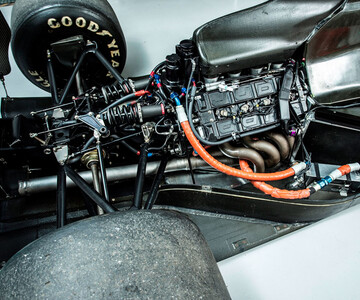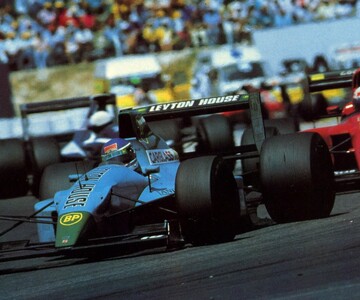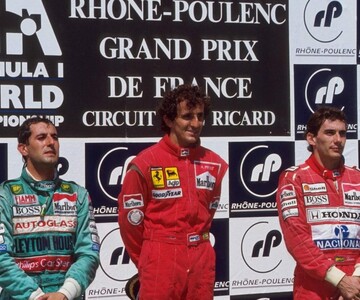The Grand Prix of France in 1990 has good reason to be highlighted and analysed. The race is seen by many engineers and teams as Adrian Newey's absolute 'breakthrough' in the Formula 1 world. Newey, who joined March in 1981 as a race engineer for Johnny Cecotto in the European Formula 2 Championship, returned to March after a few wanderings in 1988.
With Ivan Capelli at the wheel, the March 881 (with a 3.5 litre Judd engine) finished second at the Portuguese Grand Prix of 1988. The French Grand Prix in 1990 was characterized by the B-version that Adrian Newey introduced as the designer of the CG901.
Cesare Gariboldi and Adrian Newey
The initials of the March car, the CG901, come from the name Cesare Gariboldi. The Italian was the team manager at Leyton House until March 1989, when he was killed in a tragic road accident. Gariboldi was also a good friend and manager of Leyton House driver Ivan Capelli and the former chairman of the Automobile Club Milano. The Italian was a very popular figure in the then 'public-friendly' paddock and had a good sense of humour. It was also Gariboldi who  gave Adrian Newey the opportunity to return to March/Leyton House after his failed adventure with Beatrice Haas. Gardiboli was also known for his technical content and was a master at analysing problems.
gave Adrian Newey the opportunity to return to March/Leyton House after his failed adventure with Beatrice Haas. Gardiboli was also known for his technical content and was a master at analysing problems.
Adrian Newey's first car, the March 881, was a bulls-eye for Newey. With the 'normal Judd V8 CV Motor', Newey managed to get a non-turbo engine to lead a race for the first time since 1983. Despite the fact that the Judd CV 3.5 engine was about twenty kph slower than the turbo engines of Honda on the straights of Hockenheim, there were opportunities at shorter and winding circuits. In the second part of the season, the March 881 took a huge step forward and Capelli (who was known as a great talent at the time) was able to get podiums in Belgium and Portugal. The March was the third best car in the field after the McLaren and Ferrari during the last part of the season.
In the following season of 1989, the March team entered the first two races with the March 881, which brought a third place for Mauricio Gugelmin. Newey was now working in the background on a new car, the CG891. This car was designed in collaboration with the Austrian Gustav Brunner and turned out to be a 'cat in the bag'. The car was far from impressive and Gugelmin could not qualify for the Mexican Grand Prix. The team finished the season with only four points and finished twelfth in the World Championship.
The CG901
Newey was sure that the team had the potential to compete for points. An intermediate version (CG901) was used from the beginning of the season. The designer knew that Leyton House (now competing under its own name) would have a hard time at the beginning of the year. The gap to the top teams had grown and the Judd EV 3.5 V8 engine was not the most powerful of the field. Newey worked on a B-specification of the CG901, which would be used halfway through the season. In the first six Grands Prix of the year, the team was unable to qualify six times in twelve possible situations. During the United States Grand Prix on the street circuit of Phoenix, both cars only just made the cut. Capelli and Gugelmin started the race in 25th and 26th place. At the next race in Brazil both cars didn't qualify, but for the Grand Prix of San Marino Newey introduced an update and the cars were on the grid in 12th and 18th place.
Guglemin didn't qualify at Monaco, Canada and Mexico while Capelli didn't survive the elimination in Mexico either. The CG901 was far from competitive  and the team was looking forward to the B-version that would change the situation. With six zero-point scores in a row, Leyton House entered the danger zone and results were needed to ensure the survival of the team.
and the team was looking forward to the B-version that would change the situation. With six zero-point scores in a row, Leyton House entered the danger zone and results were needed to ensure the survival of the team.
Data showed that Newey had made a number of 'correlation errors' in the wind tunnel during the design of the CG901. The basis of the CG901 was an evolution of the CG891, the car that was highly unreliable in 1989. The aerodynamic package at the beginning of the season was a difficult drama and the car was a driving chicane on most circuits. The B version would end up being taken to the French Grand Prix at the circuit of Paul Ricard. The CG901 was fitted with a very advanced aerodynamic package. Newey changed the floor and the diffuser of the car. This made sure that the CG901 would have almost no tire wear.
Tests on the new version prior to the Canadian Grand Prix were very positive. Still, they decided to use the B-specification in Europe. March still had to do with the A-specification for the overseas Grand Prix. During several tests prior to the French Grand Prix, the car not only proved to be very suitable for the tyres, but it also appeared to have gained speed. The update of the Judd EV 3.5 V8 engine also turned out to be a good one. Leyton House therefore travelled with a lot of confidence to the south of France for the seventh round of the season.
The race
Capelli qualified seventh for the race and Newey's plan was to complete the race on one set of tyres. Goodyear's hardest compound was put on the car. The performance during the warm-up on Sunday morning was positive. The Leyton House was well up to speed during the short session on Sunday morning. Capelli and Gugelmin were aware that their strategy could work.
On the grid, it became clear that the top teams had opted for a softer compound and the high temperatures ensured that the strategy of these teams would be fixed right from the start. Leyton House had the option of completing the race without a stop on Paul Ricard's even asphalt.
Nigel Mansell, who started from pole position, lost the lead to Gerhard Berger. On the 27th lap, Berger stopped for a tyre change. Ayrton Senna did so two laps later, followed by Mansell and Riccardo Patrese. Alain Prost had already stopped and ended up behind the unstoppable Leyton House cars. Capelli took the lead in the 33rd lap and was followed by teammate Gugelmin.
During the middle part of the race the cars, which were unable to qualify for the previous Grand Prix, drove first and second. Prost's Ferrari finally got up to speed and caught up with Gugelmin in the 54th of 80 laps. The Brazilian was already struggling with problems at that time and his engine gave in three laps later.
Capelli, the only remaining Leyton House, was encouraged by his consistent pace. Between the Italian's slowest and fastest lap, there were only five-tenths of a second between the 50th and 70th lap. Prost, who was on fresher rubber, struggled to get the Leyton House in his sights and needed more than sheer  pace to help him. Around the 70th lap the Leyton House was in trouble due to overheating. But Capelli kept the following Frenchman behind. These were the first signs that the fairy tale could end at an early stage. Prost was approaching each lap but the Leyton House's speed on the 'Mistral' straight was too high for the Ferrari. Halfway through the 77th lap Prost saw his chance when Capelli's Judd engine started to sputter. On the straight Prost closed the gap and at the Courbe de Signes he was in Capelli's gearbox. Prost made a dummy and put his Ferrari next to the Leyton House when entering the Double Droite du Beausset. Capelli had no answer. The Frenchman was able to streak away from the Italian and won his home race for the fifth time.
pace to help him. Around the 70th lap the Leyton House was in trouble due to overheating. But Capelli kept the following Frenchman behind. These were the first signs that the fairy tale could end at an early stage. Prost was approaching each lap but the Leyton House's speed on the 'Mistral' straight was too high for the Ferrari. Halfway through the 77th lap Prost saw his chance when Capelli's Judd engine started to sputter. On the straight Prost closed the gap and at the Courbe de Signes he was in Capelli's gearbox. Prost made a dummy and put his Ferrari next to the Leyton House when entering the Double Droite du Beausset. Capelli had no answer. The Frenchman was able to streak away from the Italian and won his home race for the fifth time.
Capelli equalled his best performance ever with a second place. The fact that the Leyton House had reached the end of the race was a small miracle, as the car ran on only five cylinders during the last part of the last lap. Leyton House/March was very close to its first victory as a team. The same kind of race would happen seven years later in Hungary, when an unleashed Damon Hill was in the lead in the uncompetitive Arrows Yamaha until the very last lap.
The engine developed for Yamaha came from the same factory as the Judd engine that put Capelli in second place. The team wouldn't achieve a better performance. Gugelmin finished sixth in Belgium and at the end of 1991 the main sponsor Leyton House withdrew, as their owner, Akira Akagi, was arrested for his part in the FujiBank scandal. Nevertheless, Capelli's second place was the first example of the class that Adrian Newey has been able to show at times. It is clear that Newey has turned out to be a brilliant designer, but he is also a designer who, once in a while, is responsible for an enormous 'fault' in the design.

 5
5
























mcbhargav
Posts: 1,332
What we need is, more freedom to 'interpret' the rules to come out with stuff like re-fueling. Its been 6-7 years since any clever trick used in F1, and 10 years since a proper ground breaking hack exploited. Now, its all in the software of the sensor based controllers, and turbos, batteries. Why... [Read more]